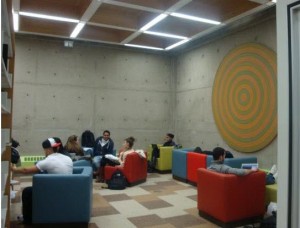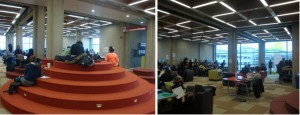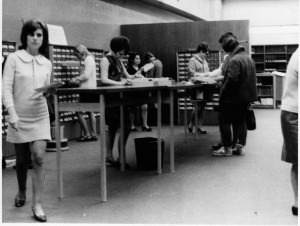I love the library! I started working as a student assistant in Scott Library in the mid-1990s and then started working full time there in 2000. I sometimes feel that I have walked the hallways of this library for a very long time, however, in reality, there are many library staff members who have worked here for 30 and even 40 years. During this time, the library and the role of the librarian have transformed as a result of changes in technology, learning and teaching styles and overall campus culture.
Construction of Scott Library started in 1968 by the University Planners, Architects and Consulting Engineers and it officially opened in 1971. It was built in the familiar York “brutalist modernist” style that dominates most of the buildings on campus. It is the largest library at York University, and together with three other library buildings on campus, houses more than 2.5 million books, subscribes to more than 16,000 electronic journals and harbours a growing number of e-resources.
As I now walk into Scott Library, the noise from Central Square carries directly into its main entrance area. People walk in all directions, giving a hustle and bustle feeling to the area that matches the atmosphere just outside the doors. Looking straight ahead, I see the very familiar Circulation Department staff actively engaged with users. Some of these staff members have been around for many years and we often talk about the “old Scott” and the way that it used to be. Originally, the first floor of this building was the York University Bookstore but when the York Lanes Mall was built, the bookstore moved there and the Library gained the space. It is here that the William Pearson (Pete) Scott plaque is located; he was one of the pillars of York University and the chairman of the Board of Governors in the 1960s. I wonder how many students walk by every day and do not know who he was. Sometimes signs and plaques disappear in the background in this busy and sometimes hectic place.
The noise around the entrance to the library on the first floor is not something that surprises me anymore, although my colleagues and I often discuss the cultural change of acceptable noise that has evolved over the years. Historically, the library is associated with a “shhhh” environment; however, this is no longer the case at York. I remember staff members having work conversations and being shushed by students studying at individual carrels. This would be rare now.
Today, most of the carrels have been replaced by desks and study spaces. The entire second floor of Scott library now caters to interaction, discussion and group work. This change has come about as a result of the adaptation of an education system that is allegedly embracing different learning and studying styles. Group work is something that is promoted in today’s academic world and the library is tasked with providing students with a place for such collaboration. I do wonder, though, if the library has created collaborative spaces at the expense of quiet study spaces where users can absorb and interact with information and resources (the original function of libraries!)? The quiet spaces are still in demand by our students at certain times of the academic year, such as exam time. I wonder too how the new collaborative environment jives with the growing competition among students? Do students in fact collaborate academically in these spaces? I think all this today as I look at the students, many of whom appear to be involved in other activities than studying, instead transforming the second floor of Scott into a social gathering space. The library also offers a safe place for students, although even here some assaults have occurred. The 24-hour library that is being offered at some key times during the year is in fact a way to offer students a social and safety zone that is lacking in other places on campus.

This is the one of the few quiet areas left in the Scott Library. As a study space, however, it looks more like a lounge to relax in rather than a study place. Dana Craig, 2013.

Cool seating areas for students in the library. Note how students launch at the site and the plug-ins for their laptop computers. Dana Craig, 2013.
For the people working in Scott Library, the physical and cultural changes are more salient than to the students, who are here for a relatively short time. Staff members have tried to keep some sense of continuity through the changes. One example of this is the plants hanging from the concrete balconies in the Atrium. The Atrium is located on the second floor and as I come up the escalator, I see the inverted pyramid shape of Scott that is distinctive and unique. Looking up I see the abundant plants that grow over the edges. We have a “green team,” comprised of various staff members that look after the flora in the library. They all have knowledge about the plants and the care they need. Although I don’t have in-depth knowledge about the plants, I know that we have dieffenbachias, peace lilies, Chinese evergreens and ferns and they all contribute to the relaxed atmosphere in the library. I think the “green team” is our way of making this building a little more ours and maybe a little more lived-in and comfortable. The plants soften the brutalist concrete structures.
A recently renovated space in Scott is the second floor (some considering it the main floor) which now has distinctive pods that are made up of two long benches on either side of an oval table placed in a semi-private wood construction. This is where users get help with their research, writing and learning skills as well as career services. These pods are very popular with users and they are located in the space now called the Learning Commons. It is interesting that we call these pods, which are vegetal encasements of seeds. Maybe we can think about our users being seeds that receive the necessary nutrients at these service points! The renovations have made a dramatic impact on the physical area as well as the services that the library offers today. They seek to satisfy different learning styles and instill critical thinking into students. The main goal of York subject librarians is to teach core research competencies and to critically analyze information in a meaningful way.

The Learning Commons. Note the learning pods to the right and left of the seating areas in the centre. Dana Craig, 2013
The Scott library of the 1970s was a very different place, made up of much more formally dressed students and staff, working with books and journals, with a computer hardly imagined. Back then, the library was not only a place of quiet study, but also a site where librarians and library staff helped people wade through the card catalogue, retrieving print books and articles.

The card catalogue was the central area of the library in 1969. This is where students perused author and subject catalogues, took down call numbers, and then retrieved the books from the stacks. Steacie Library, 1969. York University Libraries, Clara Thomas Archives & Special Collections, York University Libraries fonds (F0066) ASC07196. © York University.
Today, the Library is still a place of knowledge where ideas are formed, shared and debated. Students continue to use its resources, however, the resources now exist in very different formats. Electronic access is becoming the go-to format for information. Consequently, librarians perform their functions in a substantially different medium. When contemplating this change, I think of Mike Eisenberg, a professor and founding dean of the Information School at the University of Washington, whom I heard speak at a library conference. He said that library users in the past were faced with information scarcity, while today they are faced with information overload. It is because of this “new normal” that there is an increased need for librarians and library staff to guide users through this myriad of information. It is also due to this fact that the role of the academic librarian has changed considerably. Today we teach information literacy classes, specialized workshops and we are involved in many initiatives ranging from social justice and equality to open data, open source, digital platforms and scholarly communications. The value of the librarian can be measured by our qualifications as educators, statisticians, technology pioneers, copyright specialists, open data and scholarly communication experts and researchers. In other words the value of the librarian has changed together with the value of the library. In the past the value of the library was measured by the straight-forward questions: “How many books and journals do we have on our shelves? How many of them are being signed out by our users?” Now, we measure the physical value of the library by a turnstile counting philosophy: “How many users come through the doors?” I wonder if it should matter to us what these users do when they get in—do they study, work in groups, sleep, eat (something very recently allowed in the library) or socialize? I think that regardless of the number of bodies that come into the library and regardless of how they use the library space, the library remains the heart of the campus. One cannot truly put a measure on the value of knowledge – the library is where knowledge is preserved, shared and disseminated.
We can still measure the value of the library based on the amount of resources and services, however, the turnstile counting philosophy and the library as physical space is becoming more and more prominent.
The idea that Scott is full of books does not come easy to the occasional visitor. Most of the old pictures of students in Scott show people surrounded by volumes of print materials. Today, the majority of stacks of books are confined to the third, fourth and fifth floors. Students in fact rely more on their personal computers than the physical books and journals for their research. The theft of laptops and other belongings has emerged several times as a topic of hot debate among students, staff, Security Services and even the student newspaper.
There are now ongoing discussions about freeing up more space for students at the expense of print books. This debate is fierce in the library world, and is by no means unique to Scott. One of the architects of the Learning Commons said that the new space is not really about books, but about bringing together student support and creating a space where students can “work together”. This point of view motivates the changes in Scott. The resources and knowledge are still what drives the libraries, but new formats, accessibility, copyright, open source, scholarly communications, digitization and born digital, are all part of how and why the library is changing.

Note the continuities and changes in the same spot in 1971 and 2013. The concrete structure remains the same, as do the plants that are maintained by the library staff’s green team. The wall and the artwork that decorated it in 1971, however, have been removed in 2013 to make room for the spacious Learning Commons. Note also the addition in 2013 of study carrels on the second, third and fourth floors and the advertisement for York University plastered on the balustrade of one of the staircases. The latter is part of a campaign seeking to attract students to York in an academic environment where universities are competing for students.
As I continue to walk to my office, I am reminded that part of my commitment to York is to teach users how, when and why to interact with relevant information; and to protect, create and share resources.
Scott Library is the central hub of the university in many ways, providing collaborative space, study space, a social gathering place, a safety zone and sometimes even a second home. With so many people coming together in one space, Scott Library is bound to contain many different tensions and visions in the present and future.
Questions
- Is the library, as a quiet place where users interact with materials that are within easy reach, a thing of the past?
- Is the lack of space on campus more generally pushing libraries to become more accommodating to other pursuits than studying quietly and accessing resources, like becoming a place for socializing, talking, eating, drinking, sleeping or lounging in comfortable chairs, and yet another place to access the internet?
- What is the role of librarians? Should they be visible front-line workers interacting with students? Or should they be behind-the-scene operators acquiring and making accessible on-line resources and research material
- Will there always be an academic library? What will it look like in 20 years?
References
- Horn, M., Pietropaolo, V., & York University. (2009). York University: The Way Must Be Tried. Montreal: Published for York University by McGill-Queen's University Press.
- Next Stop, York U. Adrienne. (2012, July 9). Learning the ways of the Library. Retrieved from: http://experienceyork.apps01.yorku.ca/adrienne/2012/07/09/learning-the-ways-of-the-library-2/
- No Mean City Blog. (2012, Sept. 5). York Learning Commons by Levitt Goodman Architects. Retrieved from: http://www.nomeancity.net/york-learning-commons-by-levitt-goodman-architects/
- West, J. (2013). librarian.net. Retrieved from: http://www.librarian.net/
- York&U. Adrienne. (2012, Sept. 3). Navigating York’s Libraries. Retrieved from: http://experienceyork.apps01.yorku.ca/blog/yorkandu/2012/09/03/navigating-yorks-libraries/
- York University Clara Thomas Archives and Special Collections. (2013). York University's 50th Anniversary Photograph Collection. Photographs (© ASC#) retrieved from: http://www.library.yorku.ca/cms/archivesspecialcollections/
- York University Libraries. (2013). Retrieved from: www.library.yorku.ca
Biography of Author
Dana Craig is the Environmental Studies Liaison Librarian at York University. The interdisciplinary nature of Environmental Studies at York University allows her to be involved in many initiatives including those dealing with her background in geophysics, geography and physical environment. She teaches information literacy classes and promotes thinking critically about information and resources. Her goal is to further environmental advocacy inside, as well as outside academia.

This work is licensed under a Creative Commons Attribution-ShareAlike 3.0 Unported License.




